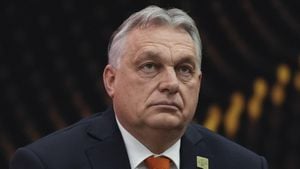The political stage is shifting dramatically with the rise of the BRICS nations—Brazil, Russia, India, China, and South Africa—now joined by new members Egypt, Ethiopia, Iran, and the United Arab Emirates during the recent summit held from October 22 to 24, 2024, in Kazan, Russia. This expansion is significant as the BRICS coalition now comprises countries representing 45% of the world's population and over 35% of global GDP. Despite this growth, the group faces internal tensions and conflicting interests, particularly concerning their relationships with Western countries.
During the BRICS summit, the leaders gathered to address several key goals, including strengthening multilateralism and enhancing cooperation for economic development and international stability. Notably, Russian President Vladimir Putin, who has received international scrutiny over his actions, including the invasion of Ukraine, used the platform to position himself as a champion for the Global South. He sought to amplify the voice of developing nations amid calls for reform of institutions like the International Monetary Fund (IMF) and World Bank.
Putin's diplomatic maneuvers during the summit highlighted the contrasts between BRICS nations. For example, India's Prime Minister Narendra Modi met with Chinese President Xi Jinping for the first time directly since 2019. This encounter, albeit brief and somewhat tentative, underscored the complexity of relations within this diverse coalition. India has enjoyed closer ties with Western nations, whereas Russia and China remain at odds with the West over various geopolitical tensions.
The summit's final communiqué contained 134 points, indicating the members' ambition to reshape the global order but also revealed substantial differences among them. For example, the contentious water-sharing dispute between Egypt and Ethiopia over the Grand Ethiopian Renaissance Dam remains unresolved and raises questions about how effectively BRICS can present itself as a unified force against Western domination.
According to experts, the internal dissonance within BRICS poses significant challenges for the group. While there is mutual interest among member states to counterbalance Western influence, divergent political orientations and bilateral disputes impede the coalition's ability to act cohesively. For example, India and China, two significant players within BRICS, have longstanding border disputes. Recent agreements to disengage at friction points indicate movement toward peace, but uncertainties linger, making it hard to trust long-term stability.
Similarly, the relationships among Gulf nations within BRICS are fraught with complexity. The UAE has normalized relations with Israel, whereas Iran views the same nation as adversarial. These differences reflect broader geopolitical divisions, complicate collaboration, and heighten suspicions among BRICS members.
On the economic front, BRICS seeks to reevaluate global financial governance largely structured to favor Western interests, primarily through the dominance of the US dollar. There are attempts to promote local currencies for trade among member countries. The Kazan summit set the foundation for discussions around de-dollarization, but significant barriers remain, particularly for nations like the UAE, which still rely heavily on dollar transactions.
Experts from various think tanks, like Natixis CIB, assert the need for Western nations to recognize and react to BRICS’ ambitions, especially as the coalition aligns itself more closely with China's Belt and Road Initiative and seeks to redesign the monetary system through reform of multilateral institutions. The group’s statements articulate aspirations for increased cooperation and security but carry overt anti-Western undertones. The call for reform reflects the intent of the Global South to assert its voice, yet the capacity of BRICS to unify under these ideals is uncertain.
BRICS’ member countries, collectively expressing the desire to create a multipolar world, may not have the political cohesion or shared objectives necessary to establish themselves as significant oppositional forces against Western influence. Notably, with nations experiencing internal unrest, external pressures, and divergent political motivations, it seems plausible they might prioritize national agendas over cohesive strategies.
Despite the ambitious rhetoric, the central question persists: Can BRICS maintain its unity and draft compelling alternatives to the existing global order? Internal disputes, varied relationships with Western nations, and the contrasting foreign policies of member countries make this endeavor exceedingly complex.
The BRICS summit’s outcomes signal the group’s intentions but, at the same time, reveal significant obstacles to achieving the transformation they desire. The ambitions of member states to redefine global governance structures and monetary systems will require sustained dialogue and resolution of the underlying geopolitical rifts. Time will tell if BRICS can rise to the challenge and present itself as not merely a collection of nations with common grievances but as a credible alternative to the Western-centric global system.



